Variations of Free-Living Marine Nematode’s Taxonomic Structure and Functional Traits in Contrasting Sandy Beach Habitats
Abstract
:1. Introduction
2. Material and Methods
2.1. Study Area
- (1)
- Golden Beach (121°35′ E, 38°52′ N; GB in short) is 1.0 km long, with an average slope of 9.0°. The average height of spring tide and neap tide is 292 cm and 235 cm, respectively [25]. It is located on the coast of the North Yellow Sea, which is situated between the Chinese mainland and the Korean Peninsula, and a line between Chengshanjiao of the Shangdong Peninsula and Changshanchuan of the Korean Peninsula is the boundary between the North Yellow Sea and the South Yellow Sea. The mean water depth is 38 m in the North Yellow Sea [26]. The tides in this area are regular semi-diurnal, with a tidal range from 2–4 m, and a current velocity of from approximately 1.5–2.5 m/s [27]. The wave height is from 2.0–6.0 m in autumn and winter in the North Yellow Sea [26].
- (2)
- Xiajiahezi Beach (121°30′ E, 39°02′ N; XB in short) is 1.2 km long, with an average slope of 1.3°. The average height of spring and neap tide is 233 cm and 194 cm [25], respectively. It is located on the coast of the Bohai Sea, a shallow semi-enclosed continental shelf sea with a mean depth of 18 m. Currents are weak with a maximum surface velocity <1.5 m/s, and the wave height is from 0.3–0.7 m on near shore areas [28]. The tides in this area are irregular semi-diurnal tides, with a tidal range from 2–3 m.
2.2. Sampling Methods
2.3. Laboratory Process
2.4. Statistical Analyses
3. Results
3.1. Habitat Heterogeneity
3.2. Species Composition of Nematode Community
3.3. Feeding Types of Nematode Community
3.4. Life Strategies of Nematode Community
3.5. Relationships between Nematode Datasets and Environmental Variables
4. Discussion
4.1. Variation in Nematode Taxonomic Structure and Functional Traits in Fine Sand Habitat
4.2. Variation in Nematode Taxonomic Structure and Functional Traits in Coarse Sand Habitat
5. Conclusions
Author Contributions
Funding
Data Availability Statement
Conflicts of Interest
References
- McLachlan, A.; Defeo, O. The Ecology of Sandy Shores, 3rd ed.; Academic Press: London, UK, 2018; ISBN 978-0-12-809467-9. [Google Scholar]
- McLachlan, A.; Turner, I. The interstitial environment of sandy beaches. Mar. Ecol. 1994, 15, 177–211. [Google Scholar] [CrossRef]
- Gheskiere, T.; Vincx, M.; Urban-Malinga, B.; Rossano, C.; Scapini, F.; Degraer, S. Nematodes from wave-dominated sandy beaches: Diversity, zonation patterns and testing of the isocommunities concept. Estuar. Coast. Shelf Sci. 2005, 62, 365–375. [Google Scholar] [CrossRef] [Green Version]
- Giere, O. Meiobenthology: The Microscopic Motile Fauna of Aquatic Sediments, 2nd ed.; Springer: Berlin/Heidelberg, Germany, 2009; ISBN 978-3-540-68657-6. [Google Scholar]
- Urban-Malinga, B.; Hedtkamp, S.I.C.; van Beusekom, J.E.E.; Wiktor, J.; Węslawski, J.M. Comparison of nematode communities in baltic and North Sea sublittoral, permeable sands–diversity and environmental control. Estuar. Coast. Shelf Sci. 2006, 70, 224–238. [Google Scholar] [CrossRef]
- Heip, C.; Vinx, M.; Vranken, G. The ecology of marine nematodes. Oceanogr. Mar. Biol. 1985, 23, 399–489. [Google Scholar]
- Nicholas, W.L.; Hodda, M. The free-living nematodes of a temperate, high energy, sandy beach: Faunal composition and variation over space and time. Hydrobiologia 1999, 394, 113–127. [Google Scholar] [CrossRef]
- Nicholas, W.L. Seasonal variations in nematode assemblages on an Australian temperate ocean beach; the effect of heavy seas and unusually high tides. Hydrobiologia 2001, 464, 17–26. [Google Scholar] [CrossRef]
- Gheskiere, T.; Hoste, E.; Vanaverbeke, J.; Vincx, M.; Degraer, S. Horizontal zonation patterns and feeding structure of marine nematode assemblages on a macrotidal, ultra-dissipative sandy beach (De Panne, Belgium). J. Sea Res. 2004, 52, 211–226. [Google Scholar] [CrossRef] [Green Version]
- Lee, M.R.; Riveros, M. Latitudinal trends in the species richness of free-living marine nematode assemblages from exposed sandy beaches along the coast of Chile (18–42° S). Mar. Ecol. 2012, 33, 317–325. [Google Scholar] [CrossRef]
- Cooke, B.C.; Goodwin, I.D.; Bishop, M.J. Small-scale spatial structuring of interstitial invertebrates on three embayed beaches, Sydney, Australia. Estuar. Coast. Shelf Sci. 2014, 150, 92–101. [Google Scholar] [CrossRef]
- Hua, E.; Zhang, Z.N.; Zhou, H.; Mu, F.H.; Li, J.; Zhang, T.; Cong, B.Q.; Liu, X.S. Meiofauna Distribution in Intertidal Sandy Beaches Along China Shoreline(18–40° N). J. Ocean Univ. China 2016, 15, 19–27. [Google Scholar] [CrossRef]
- Maria, T.F.; Silva Filho, M.G.; Souza, T.P.; Vanaverbeke, J.; Vanreusel, A.; Esteves, A.M. Is the vertical distribution of meiofauna similar in two contrasting microhabitats? A case study of a macrotidal sandy beach. J. Exp. Mar. Biol. Ecol. 2018, 502, 39–51. [Google Scholar] [CrossRef]
- Sahraeian, N.; Sahafi, H.H.; Mosallanejad, H.; Ingels, J.; Semprucci, F. Temporal and spatial variability of free-living nematodes in a beach system characterized by domestic and industrial impacts (Bandar Abbas, Persian Gulf, Iran). Ecol. Indic. 2020, 118, 106697. [Google Scholar] [CrossRef]
- Hua, E.; Mu, F.H.; Zhang, Z.N.; Yang, S.C.; Zhang, T.; Li, J. Nematode community structure and diversity pattern in sandy beaches of Qingdao, China. J. Ocean Univ. China 2016, 15, 33–40. [Google Scholar] [CrossRef]
- Wieser, W. The effect of grain size on the distribution of small invertebrates inhabiting the beaches of Puget Sound. Limnol. Oceanogr. 1959, 4, 181–194. [Google Scholar] [CrossRef] [Green Version]
- Vanaverbeke, J.; Gheskiere, T.; Steyaert, M.; Vincx, M. Nematode assemblages from subtidal sandbanks in the Southern Bight of the North Sea: Effect of small sedimentological differences. J. Sea Res. 2002, 48, 197–207. [Google Scholar] [CrossRef]
- Vanaverbeke, J.; Merckx, B.; Degraer, S.; Vincx, M. Sediment-related distribution patterns of nematodes and macrofauna: Two sides of the benthic coin? Mar. Environ. Res. 2011, 71, 31–40. [Google Scholar] [CrossRef]
- Schratzberger, M.; Warr, K.; Rogers, S.I. Functional diversity of nematode communities in the southwestern North Sea. Mar. Environ. Res. 2007, 63, 368–389. [Google Scholar] [CrossRef] [Green Version]
- Liu, X.; Liu, Q.; Zhang, Y.; Hua, E.; Zhang, Z. Effects of Yellow Sea Cold Water Mass on marine nematodes based on biological trait analysis. Mar. Environ. Res. 2018, 141, 167–185. [Google Scholar] [CrossRef]
- Liao, J.-X.; Wei, C.-L.; Yasuhara, M. Species and Functional Diversity of Deep-Sea Nematodes in a High Energy Submarine Canyon. Front. Mar. Sci. 2020, 7, 591. [Google Scholar] [CrossRef]
- Sroczynska, K.; Chainho, P.; Vieira, S.; Adão, H. What makes a better indicator? Taxonomic vs functional response of nematodes to estuarine gradient. Ecol. Indic. 2021, 121, 107113. [Google Scholar] [CrossRef]
- Lv, Y.; Zhang, W.D.; Gao, Y.; Ning, S.X.; Yang, B. Preliminary study on responses of marine nematode community to crude oil contamination in intertidal zone of Bathing Beach, Dalian. Mar. Pollut. Bull. 2011, 62, 2700–2706. [Google Scholar] [CrossRef]
- Song, H.L.; Mu, F.H.; Sun, Y.; Hua, E. Comparison of community structure and diversity of free-living marine nematodes in the sandy intertidal zone of Dalian in winter. Haiyang Xuebao 2021, 43, 139–151. [Google Scholar]
- National Marine Data and Information Service. Tide Tables; China Ocean Press: Beijing, China, 2016; Volume 1, ISBN 9787502791278. [Google Scholar]
- Su, J.L.; Yuan, L.Y. Hydrology in China Offshore; China Ocean Press: Beijing, China, 2005; ISBN 9787502762926. [Google Scholar]
- Xu, F.X. Lectures on ocean wave forecast part 5: Geographical distribution and seasonal variation of ocean waves. Mar. Forecasts 2002, 19, 74–79. [Google Scholar]
- Song, J.M.; Duan, L.Q. The Bohai Sea. In World Seas: An Environmental Evaluation, 2nd ed.; Sheppard, C., Ed.; Academic Press: London, UK, 2019; Chapter 17; pp. 377–394. ISBN 978-0-08-100853-9. [Google Scholar]
- Platt, H.M.; Warwick, R.M. Free-Living Marine Nematodes: Part I British Enoplids; Cambridge University Press: Cambridge, UK, 1983; ISBN 0-521-25422-1. [Google Scholar]
- Platt, H.M.; Warwick, R.M. Free-Living Marine Nematodes: Part II British Chromadorids; Brill Academic Publishing: Leiden, The Netherland, 1988; ISBN 90-04-08595-5. [Google Scholar]
- Warwick, R.M.; Platt, H.M.; Somerfield, P.J. Free-Living Marine Nematodes: Part III British Monhysterids; Field Studies Council: Shrewsbury, UK, 1998; ISBN 1-85153-260-9. [Google Scholar]
- Nemys. Nemys: World Database of Nematodes. 2022. Available online: https://nemys.ugent (accessed on 19 July 2022). [CrossRef]
- Wieser, W. Die Beziehung zwischen Mundhöhlengestalt, Ernährungsweise und Vorkommen bei freilebenden marinen Nematoden. Eine skologisen-morphologische studie. Ark. Zool. 1953, 4, 439–484. [Google Scholar]
- Bongers, T.; Alkemade, R.; Yeates, G.W. Interpretation of disturbance induced maturity decrease in marine nematode assemblages by means of the maturity index. Mar. Ecol. Prog. Ser. 1991, 76, 135–142. [Google Scholar] [CrossRef]
- Bongers, T.; Bongers, M. Functional diversity of nematodes. Appl. Soil Ecol. 1998, 10, 239–251. [Google Scholar] [CrossRef]
- Liu, C.; Zhu, Z.; He, X.L.; Zhang, B.; Ning, X. Rapid determination of organic carbon in marine sediment samples by potassium dichromate oxidation ferrous sulphate titrimetry. Rock Miner. Anal. 2007, 26, 205–208. [Google Scholar]
- Lorenzen, C.J.; Jeffrey, S.W. Determination of chlorophyll in seawater. Unesco Technical Papers in Marine Science. SCORUNE-SCO 1980, 35, 1–12. [Google Scholar]
- Liu, H.; Wu, Y.P.; Gao, S.D.; Zhang, Z.N. The variations of chlorophyll-a and phaeophytin in the sediment of Jimo shrimp pond before the outbreak of shrimp disease. Trans. Oceanol. Limnol. 1998, 1, 65–69. [Google Scholar]
- Clarke, K.R.; Gorley, R.N. PRIMER v7: User Manual/Tutorial (Plymouth Routines in Multivariate Ecological Research); PRIMER-E: Plymouth, UK, 2015. [Google Scholar]
- Anderson, M.J.; Gorley, R.N.; Clarke, K.R. PERMANOVA+ for PRIMER: Guide to Software and Statistical Methods; PRIMER-E: Plymouth, UK, 2008. [Google Scholar]
- Maria, T.F.; Paiva, P.; Vanreusel, A.; Esteves, A.M. The relationship between sandy beach nematodes and environmental characteristics in two Brazilian sandy beaches (Guanabara Bay, Rio de Janeiro). An. Acad. Bras. Ciênc. 2013, 85, 257–270. [Google Scholar] [CrossRef] [Green Version]
- Baldrighi, E.; Grall, J.; Quillien, N.; Carriço, R.; Verdon, V.; Zeppilli, D. Meiofauna communities’ response to an anthropogenic pressure: The case study of green macroalgal bloom on sandy beach in Brittany. Estuar. Coast. Shelf Sci. 2019, 227, 106326. [Google Scholar] [CrossRef]
- Fonseca, G.; Maria, T.F.; Kandratavicius, N.; Venekey, V.; Gheller, P.E.; Gallucci, F. Testing for nematode–granulometry relationships. Mar. Biodivers. 2014, 44, 435–443. [Google Scholar] [CrossRef]
- Fenchel, T.M. The Ecology of Micro-and Meiobenthos. Annu. Rev. Ecol. Syst. 1978, 9, 99–121. [Google Scholar] [CrossRef]
- Ingels, J.; dos Santos, G.; Hicks, N.; Vazquez, Y.V.; Neres, P.F.; Pontes, L.P.; Amorim, M.N.; Román, S.; Du, Y.; Stahl, H.; et al. Short-term CO2 exposure and temperature rise effects on metazoan meiofauna and free-living nematodes in sandy and muddy sediments: Results from aflume experiment. J. Exp. Mar. Biol. Ecol. 2018, 502, 211–226. [Google Scholar] [CrossRef] [Green Version]
- Hua, E.; Zhu, Y.; Huang, D.; Liu, X. Are free-living nematodes effective environmental quality indicators? Insights from Bohai Bay, China. Ecol. Indic. 2021, 127, 107756. [Google Scholar] [CrossRef]
- Moens, T.; Vincx, M. Observations on the feeding ecology of estuarine nematodes. J. Mar. Biol. Assoc. U. K. 1997, 77, 211–227. [Google Scholar] [CrossRef]
- Hooper, D.U.; Chapin, F.S., III.; Ewel, J.J.; Hector, A.; Inchausti, P.; Lavorel, S.; Lawton, J.H.; Lodge, D.M.; Loreau, M.; Naeem, S.; et al. Effects of biodiversity on ecosystem functioning: A consensus of current knowledge. Ecol. Monogr. 2005, 75, 3–35. [Google Scholar] [CrossRef]
- Petchey, O.L.; Gaston, K.J. Functional diversity: Back to basics and looking forward. Ecol. Lett. 2006, 9, 741–758. [Google Scholar] [CrossRef]
- Fonseca, G.; Muthumbi, A.W.; Vanreusel, A. Species richness of the genus Molgolaimus (Nematoda) from local to ocean scale along continental slopes. Mar. Ecol. 2007, 28, 446–459. [Google Scholar] [CrossRef]
- Moens, T.; Braeckman, U.; Derycke, S.; Fonseca, G.; Gallucci, F.; Gingold, R.; Guilini, K.; Ingels, J.; Leduc, D.; Vanaverbeke, J.; et al. Ecology of free-living marine nematodes. In Handbook of Zoology; Schmidt-Rhaesa, A., Ed.; De Gruyter: Berlin, Germany, 2013; pp. 109–152. ISBN 978-3-11-027425-7. [Google Scholar]
- Hellwig-Armonies, M.; Armonies, W.; Lorenzen, S. The diet of Enoplus brevis (Nematoda) in a supralittoral salt-marsh of the North Sea. Helgol. Mar. Res. 1991, 45, 357–372. [Google Scholar]
- Riera, R.; Núez, J.; Brito, M.D.C.; Tuya, F. Temporal variability of a subtropical intertidal meiofaunal assemblage: Contrasting effects at the species and assemblage-level. Vie Milieu 2011, 61, 129–137. [Google Scholar]
- Harris, R.P. The distribution and ecology of the interstitial meiofauna of a sandy beach at Whitsand Bay, East Cornwall. J. Mar. Biol. Assoc. U. K. 1972, 52, 1–18. [Google Scholar] [CrossRef]
- Santos, T.M.T.; Petracco, M.; Venekey, V. Recreational activities trigger changes in meiofauna and free-living nematodes on Amazonian macrotidal sandy beaches. Mar. Environ. Res. 2021, 167, 105289. [Google Scholar] [CrossRef]
- Moreno, M.; Ferrero, T.J.; Gallizia, I.; Vezzulli, L.; Albertelli, G.; Fabiano, M. An assessment of the spatial heterogeneity of environmental disturbance within an enclosed harbor through the analysis of meiofauna and nematode assemblages. Estuar. Coast. Shelf Sci. 2008, 77, 565–576. [Google Scholar] [CrossRef]
- Alves, A.S.; Adão, H.; Ferrero, T.J.; Marques, J.C.; Costa, M.J.; Patrício, J. Benthic meiofauna as indicator of ecological changes in estuarine ecosystems: The use of nematodes in ecological quality assessment. Ecol. Indic. 2013, 24, 462–475. [Google Scholar] [CrossRef]

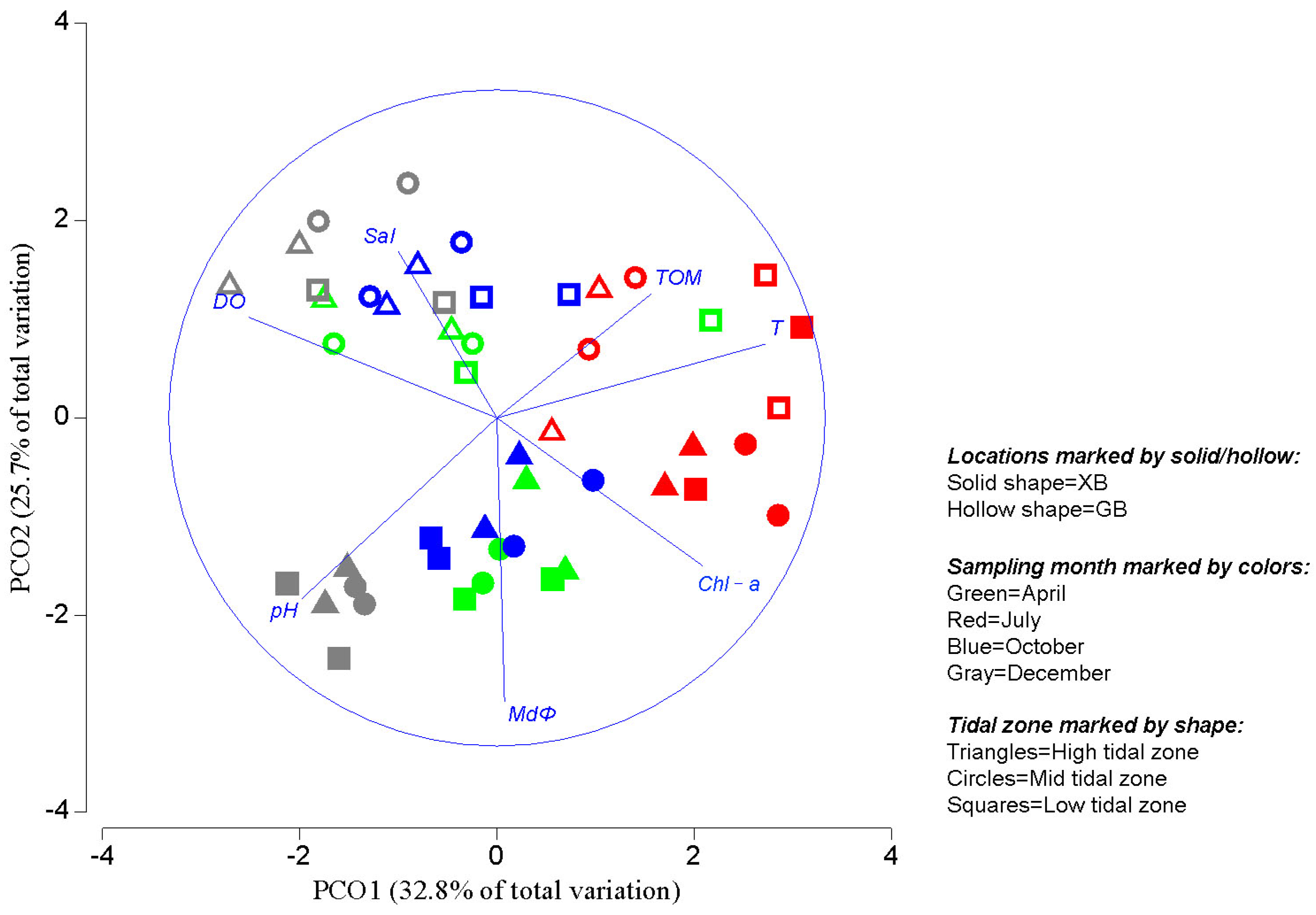


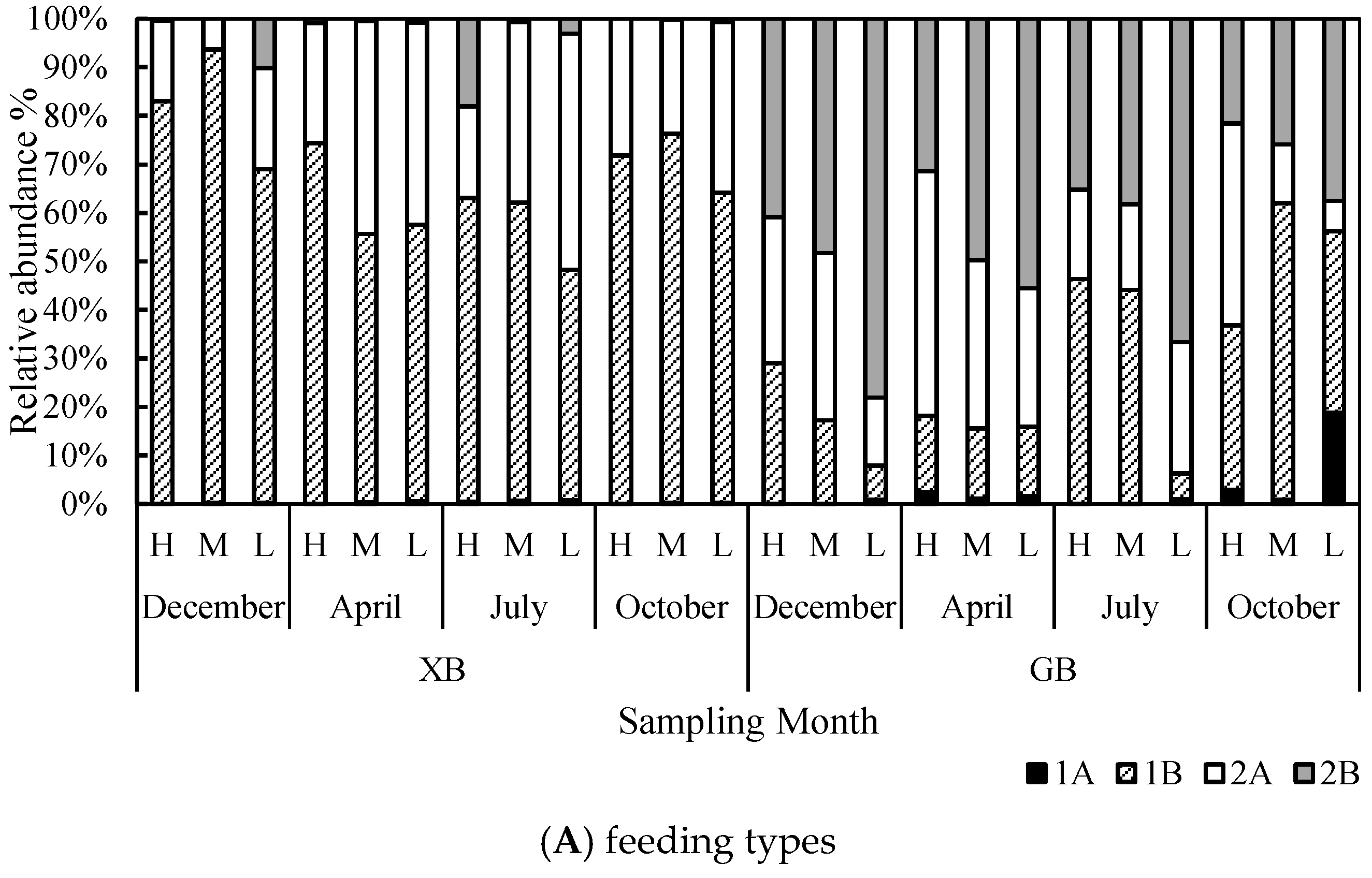
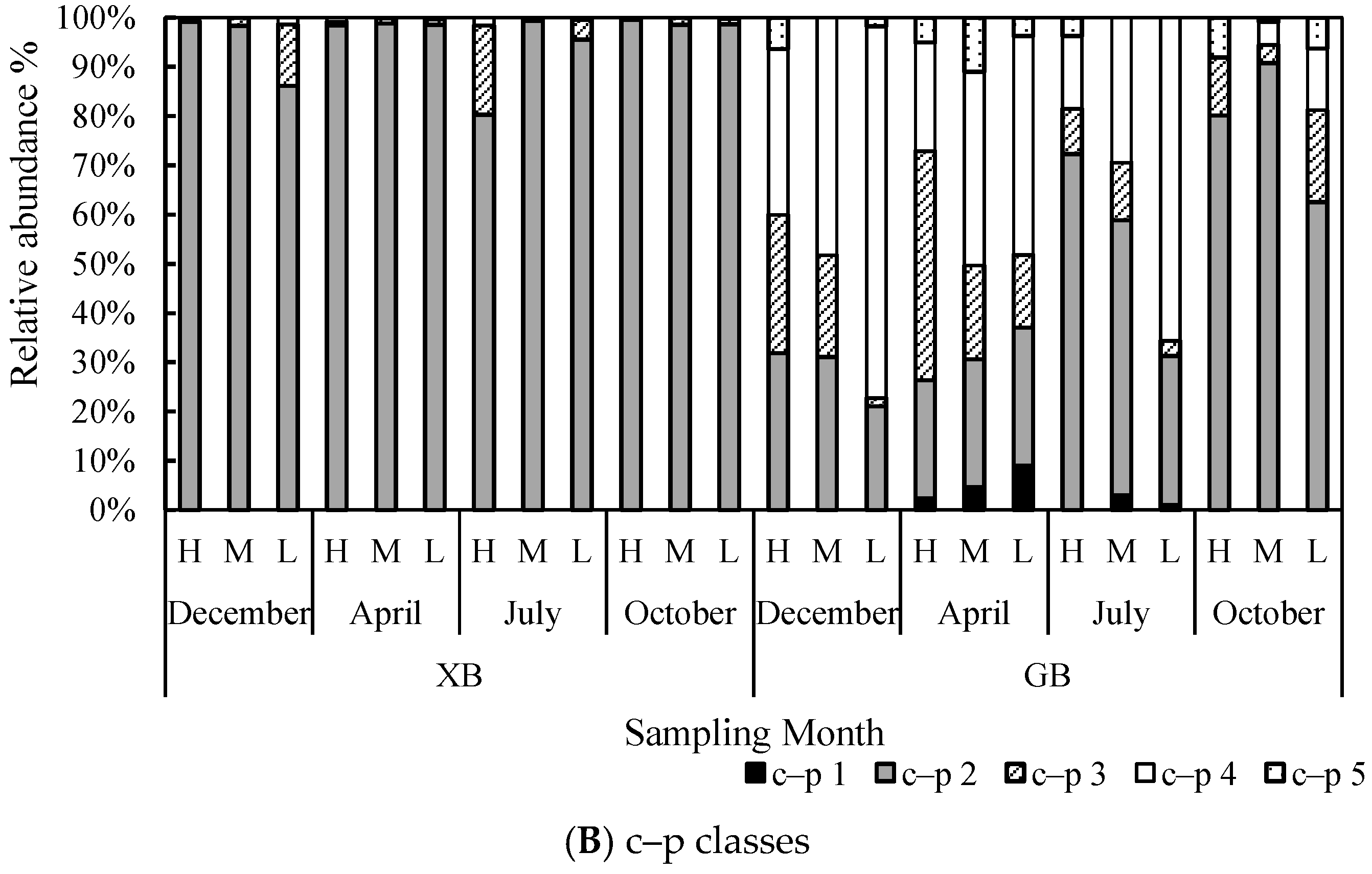
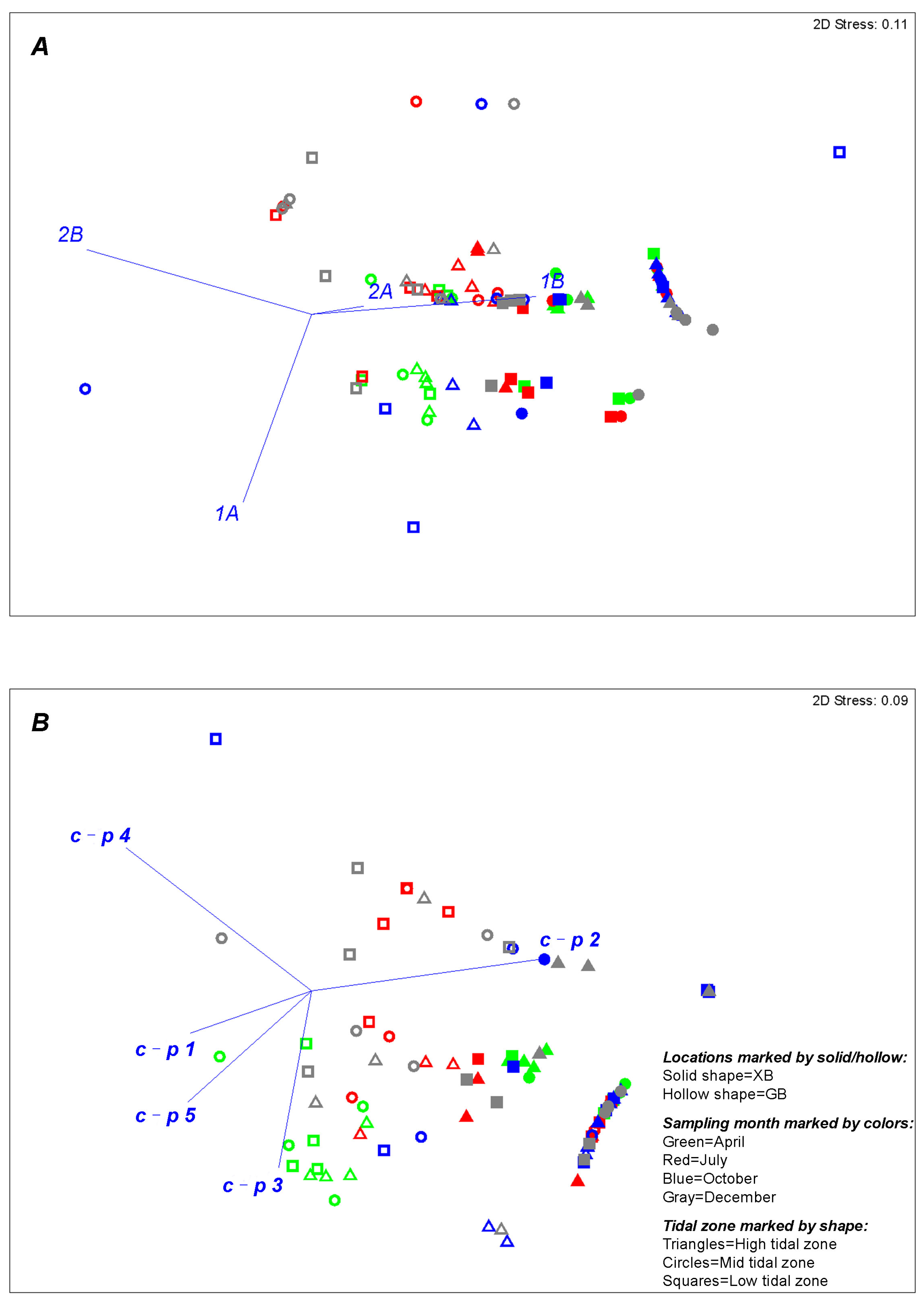
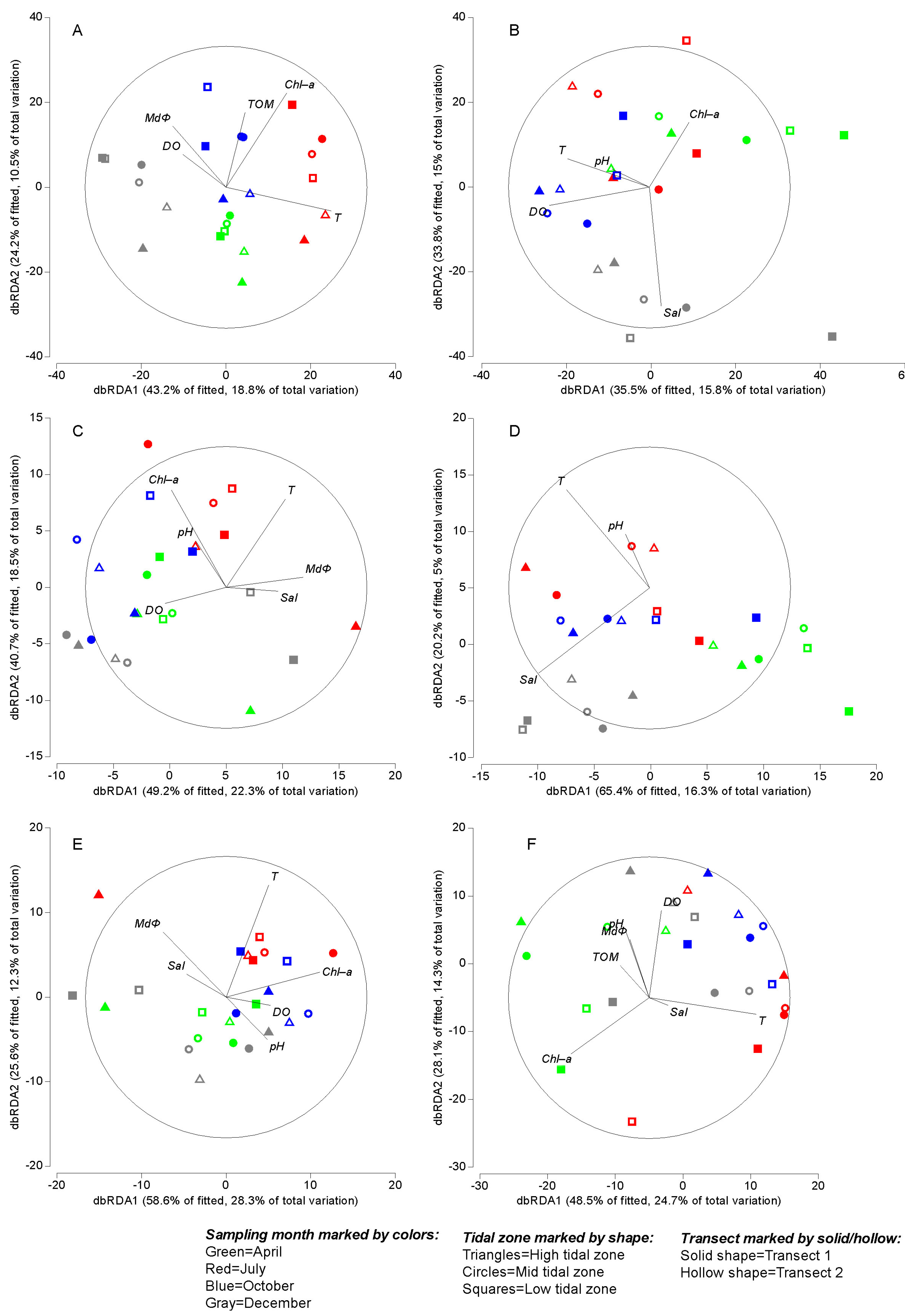
| Characteristics | Golden Beach | Xiajiahezi Beach |
|---|---|---|
| Geographic location | 121°35′ E, 38°52′ N | 121°30′ E, 39°02′ N |
| Length (m) | 1000 | 1200 |
| Slope (°) | 9 | 1.3 |
| Beach exposure | Exposed | Exposed |
| Sediment texture | Coarse sand (CS) | Fine sand (FS) |
| Median grain size (μm) | 939 ± 315 | 159 ± 21 |
| Sediment sorting | 0.87 ± 0.42 (moderate-sorted) | 0.41 ± 0.06 (well-sorted) |
| Human impact | Disturbed | Disturbed |
| Sampling Month | Tidal Zone | T (°C) | pH | DO (μg/L) | Salinity | Chl-a (μg/g) | TOM (%) | Mdφ | Sediment Texture |
|---|---|---|---|---|---|---|---|---|---|
| XB | |||||||||
| December | H | 2.45 | 8.33 | 5.53 | 28.80 | 1.07 | 0.10 | 2.59 | Fine sand |
| M | 1.19 | 8.23 | 5.53 | 28.80 | 1.76 | 0.04 | 2.72 | Fine sand | |
| L | 0.74 | 8.47 | 3.86 | 30.20 | 0.73 | 0.04 | 3.14 | Fine sand | |
| April | H | 13.94 | 7.93 | 2.17 | 29.45 | 1.62 | 0.09 | 2.48 | Fine sand |
| M | 11.56 | 8.27 | 1.83 | 30.90 | 2.14 | 0.29 | 2.51 | Fine sand | |
| L | 12.29 | 8.13 | 2.77 | 28.35 | 1.84 | 0.06 | 2.61 | Fine sand | |
| July | H | 27.39 | 7.73 | 2.64 | 31.60 | 3.46 | 0.08 | 2.66 | Fine sand |
| M | 28.15 | 7.98 | 1.84 | 30.45 | 4.13 | 2.25 | 2.53 | Fine sand | |
| L | 28.09 | 8.06 | 2.27 | 31.85 | 3.42 | 3.46 | 2.53 | Fine sand | |
| October | H | 15.44 | 8.15 | 5.65 | 30.65 | 2.70 | 1.15 | 2.50 | Fine sand |
| M | 14.88 | 7.91 | 5.26 | 31.00 | 4.26 | 0.36 | 2.57 | Fine sand | |
| L | 14.84 | 8.27 | 6.88 | 32.15 | 3.83 | 0.13 | 2.95 | Fine sand | |
| GB | |||||||||
| December | H | 7.00 | 8.12 | 9.21 | 34.00 | 0.09 | 0.84 | 0.47 | Coarse sand |
| M | 8.10 | 7.82 | 7.07 | 33.95 | 0.19 | 0.80 | −0.32 | Very coarse sand | |
| L | 7.79 | 7.91 | 5.22 | 35.00 | 0.44 | 0.75 | 1.30 | Coarse sand | |
| April | H | 9.20 | 8.04 | 7.60 | 31.70 | 1.66 | 0.84 | −0.10 | Very coarse sand |
| M | 8.39 | 8.10 | 5.94 | 31.10 | 1.32 | 0.80 | −0.21 | Very coarse sand | |
| L | 9.77 | 7.67 | 2.12 | 30.25 | 2.23 | 0.75 | −0.15 | Very coarse sand | |
| July | H | 25.88 | 8.01 | 3.55 | 29.70 | 0.58 | 0.88 | 0.55 | Coarse sand |
| M | 25.76 | 7.91 | 2.53 | 29.70 | 0.74 | 0.83 | −0.46 | Very coarse sand | |
| L | 23.66 | 7.48 | 1.70 | 29.15 | 3.99 | 0.78 | −0.34 | Very coarse sand | |
| October | H | 17.07 | 8.02 | 7.65 | 31.45 | 0.08 | 0.88 | 0.31 | Coarse sand |
| M | 17.65 | 8.01 | 6.94 | 32.00 | 0.09 | 0.83 | 0.08 | Coarse sand | |
| L | 18.59 | 7.80 | 5.05 | 29.85 | 0.56 | 0.78 | −0.12 | Very coarse sand | |
| Species | December | April | July | October | ||||||||
|---|---|---|---|---|---|---|---|---|---|---|---|---|
| H | M | L | H | M | L | H | M | L | H | M | L | |
| XB | ||||||||||||
| Axonolaimus sp. 1 | 5.5 | 7.3 | 7.5 | |||||||||
| Axonolaimus sp. 2 | 8.9 | |||||||||||
| Bathylaimus sp. 1 | 6.3 | 12.4 | 8.3 | 11.9 | 28.1 | 28.6 | 8.3 | |||||
| Chromaspirina sp. 1 | 2.5 | |||||||||||
| Cobbia sp. 1 | 2.8 | 1.8 | ||||||||||
| Daptonema sp. 1 | 12.3 | 33.6 | 14.4 | 11.8 | 10.5 | 13.3 | 25.8 | 15.6 | 5.1 | |||
| Daptonema sp. 2 | 14.2 | 24.3 | 14.8 | 11.9 | 13.6 | 11.9 | 8.9 | 8.2 | 4.1 | 17.7 | 5.7 | 13.9 |
| Daptonema sp. 3 | 15.4 | 5.2 | 12.3 | 12.4 | 4.9 | 20.9 | 17.4 | |||||
| Daptonema sp. 5 | 3.1 | 3.8 | 5.2 | |||||||||
| Daptonema sp. 6 | 4.0 | 12.4 | ||||||||||
| Dichromadora sp. 1 | 9.6 | 8.4 | 15.2 | |||||||||
| Linhomoeus sp. 1 | 3.7 | |||||||||||
| Metalinhomoeus sp. 1 | 3.0 | |||||||||||
| Odontophora sp. 2 | 9.9 | |||||||||||
| Paracomesoma sp. 1 | 3.5 | |||||||||||
| Paracyatholaimus sp. 1 | 9.6 | 10.4 | 13.3 | 11.8 | 8.6 | 24.5 | 14.0 | 22.5 | 15.8 | 19.4 | ||
| Prochromadorella sp. 1 | 14.1 | 13.3 | 6.6 | 10.3 | 8.7 | 10.5 | 7.1 | |||||
| Sabatieria sp. 2 | 11.9 | 8.7 | 9.4 | 11.5 | 18.2 | 18.3 | 11.2 | 20.8 | 9.9 | 10.9 | ||
| Setosabatieria sp. 1 | 19.1 | 15.7 | 3.1 | 4.5 | 12.9 | 5.5 | 18.2 | |||||
| Theristus sp. 1 | 14.3 | 11.8 | 11.9 | 5.0 | 8.3 | |||||||
| Viscosia sp. 1 | 12.9 | 11.3 | ||||||||||
| GB | ||||||||||||
| Axonolaimus sp. 3 | 34.6 | |||||||||||
| Bathylaimus sp. 1 | 11.8 | |||||||||||
| Bathylaimus sp. 2 | 12.7 | 24.7 | ||||||||||
| Chromadorita sp. 1 | 33.7 | 25.5 | 18.7 | 11.1 | 14.1 | 25.2 | 4.9 | |||||
| Chromadorita sp. 2 | 13.8 | 6.1 | ||||||||||
| Daptonema sp. 1 | 4.7 | |||||||||||
| Dichromadora sp. 1 | 21.0 | 19.5 | 7.4 | 42.0 | ||||||||
| Enoplolaimus sp. 1 | 5.7 | 11.8 | 23.2 | 13.9 | 23.7 | 52.5 | ||||||
| Enoplolaimus sp. 2 | 5.8 | |||||||||||
| Enoplus sp. 1 | 9.3 | 12.4 | 18.4 | 7.2 | 5.5 | |||||||
| Metalinhomoeus sp. 3 | 4.9 | 6.4 | 5.9 | |||||||||
| Neochromadora sp. 1 | 8.1 | 7.8 | ||||||||||
| Oncholaimus sp. 1 | 36.4 | 58.5 | 64.4 | 18.0 | 25.5 | 15.0 | 17.9 | 30.3 | 5.9 | |||
| Oncholaimus sp. 2 | 8.3 | 8.9 | 16.5 | 8.8 | 49.4 | |||||||
| Prochromadorella sp. 1 | 5.5 | 7.0 | ||||||||||
| Promonhystera sp. 1 | 12.2 | 37.9 | 10.5 | 10.2 | 28.0 | 47.5 | ||||||
| Rhabditis sp. 1 | 12.4 | 14.7 | ||||||||||
| Theristus sp. 2 | 9.3 | 10.5 | ||||||||||
| Datasets | Variable | Adjusted R2 | SS (Trace) | Pseudo-F | p | Prop. | Cumul. |
|---|---|---|---|---|---|---|---|
| Species | MdΦ | 0.35361 | 50744 | 26.711 | 0.001 ** | 0.367 | 0.367 |
| T | 0.39126 | 6878.9 | 3.8449 | 0.001 ** | 0.050 | 0.417 | |
| DO | 0.42678 | 6383.4 | 3.7891 | 0.001 ** | 0.046 | 0.463 | |
| Sal | 0.44807 | 4375 | 2.6971 | 0.008 ** | 0.032 | 0.495 | |
| Chl-a | 0.46599 | 3833.8 | 2.4428 | 0.010 ** | 0.028 | 0.523 | |
| pH | 0.47721 | 2921.3 | 1.9013 | 0.038 * | 0.021 | 0.544 | |
| Feeding type | MdΦ | 0.29595 | 4940.5 | 20.757 | 0.001 ** | 0.311 | 0.311 |
| Sal | 0.35133 | 1080.6 | 4.9277 | 0.018 ** | 0.068 | 0.379 | |
| Chl-a | 0.35991 | 346.85 | 1.6028 | 0.213 | 0.022 | 0.401 | |
| DO | 0.36772 | 329.99 | 1.5437 | 0.276 | 0.021 | 0.422 | |
| c–p class | MdΦ | 0.44308 | 11106 | 38.392 | 0.001 ** | 0.455 | 0.455 |
| Chl-a | 0.468 | 871.76 | 3.1548 | 0.037 * | 0.036 | 0.491 | |
| T | 0.48811 | 735.97 | 2.768 | 0.069 | 0.030 | 0.521 | |
| pH | 0.52019 | 982.33 | 3.9416 | 0.025 * | 0.040 | 0.561 | |
| Sal | 0.54054 | 693.15 | 2.9045 | 0.084 | 0.028 | 0.589 | |
| DO | 0.56051 | 663.97 | 2.9086 | 0.065 | 0.027 | 0.617 |
| Datasets | Variable | Adjusted R2 | SS (Trace) | Pseudo-F | p | Prop. | Cumul. |
|---|---|---|---|---|---|---|---|
| Species | T | 0.14377 | 5461.1 | 4.8619 | 0.001 ** | 0.181 | 0.181 |
| MdΦ | 0.19345 | 2491.7 | 2.355 | 0.009 ** | 0.082583 | 0.26358 | |
| Chl-a | 0.24221 | 2337.4 | 2.3512 | 0.014 * | 0.077468 | 0.34105 | |
| TOM | 0.26493 | 1560.5 | 1.6183 | 0.085 | 0.051719 | 0.39277 | |
| DO | 0.27968 | 1312.6 | 1.3891 | 0.178 | 0.043505 | 0.43627 | |
| Feeding type | T | 0.072248 | 477.63 | 2.7911 | 0.052 | 0.11258 | 0.11258 |
| MdΦ | 0.13865 | 428.33 | 2.6959 | 0.071 | 0.10096 | 0.21355 | |
| Chl-a | 0.21654 | 446.25 | 3.088 | 0.060 | 0.10519 | 0.31873 | |
| pH | 0.24107 | 230.46 | 1.6463 | 0.248 | 0.054324 | 0.37306 | |
| DO | 0.25432 | 183.99 | 1.3377 | 0.300 | 0.043369 | 0.41643 | |
| Sal | 0.26035 | 156.45 | 1.1468 | 0.336 | 0.036878 | 0.4533 | |
| c–p class | Chl-a | 0.12532 | 813.26 | 4.2954 | 0.014 * | 0.16335 | 0.16335 |
| Sal | 0.16523 | 370.75 | 2.0518 | 0.156 | 0.074469 | 0.23782 | |
| pH | 0.2073 | 362.81 | 2.1144 | 0.156 | 0.072875 | 0.31069 | |
| MdΦ | 0.25933 | 385.56 | 2.4048 | 0.118 | 0.077444 | 0.38814 | |
| T | 0.29537 | 300.75 | 1.9718 | 0.184 | 0.060409 | 0.44855 | |
| DO | 0.29929 | 166.97 | 1.1008 | 0.348 | 0.033537 | 0.48209 |
| Datasets | Variable | Adjusted R2 | SS (trace) | Pseudo-F | p | Prop. | Cumul. |
|---|---|---|---|---|---|---|---|
| Species | Sal | 0.091863 | 7340.8 | 3.3266 | 0.002 ** | 0.13135 | 0.13135 |
| DO | 0.18032 | 6720.7 | 3.3742 | 0.002 ** | 0.12025 | 0.2516 | |
| T | 0.26204 | 5963.2 | 3.3255 | 0.002 ** | 0.1067 | 0.3583 | |
| pH | 0.27664 | 2467.4 | 1.4037 | 0.193 | 0.044148 | 0.40244 | |
| Chl-a | 0.28886 | 2292 | 1.3264 | 0.195 | 0.04101 | 0.44345 | |
| Feeding type | Sal | 0.035052 | 782.95 | 1.8355 | 0.162 | 0.077006 | 0.077006 |
| T | 0.13367 | 1342 | 3.5043 | 0.033 * | 0.132 | 0.209 | |
| pH | 0.13633 | 406.54 | 1.0648 | 0.362 | 0.039985 | 0.24899 | |
| c–p class | Chl-a | 0.094041 | 1838.5 | 3.3875 | 0.027 * | 0.13343 | 0.13343 |
| T | 0.19001 | 1750.1 | 3.6066 | 0.019 * | 0.12701 | 0.26044 | |
| DO | 0.23754 | 1054.7 | 2.309 | 0.099 | 0.076546 | 0.33699 | |
| pH | 0.2515 | 615.75 | 1.3732 | 0.271 | 0.044689 | 0.38168 | |
| MdΦ | 0.26062 | 546.69 | 1.2342 | 0.311 | 0.039676 | 0.42135 | |
| TOM | 0.27757 | 615.58 | 1.4223 | 0.274 | 0.044676 | 0.46603 | |
| Sal | 0.29318 | 582.43 | 1.3755 | 0.282 | 0.04227 | 0.5083 |
Publisher’s Note: MDPI stays neutral with regard to jurisdictional claims in published maps and institutional affiliations. |
© 2022 by the authors. Licensee MDPI, Basel, Switzerland. This article is an open access article distributed under the terms and conditions of the Creative Commons Attribution (CC BY) license (https://creativecommons.org/licenses/by/4.0/).
Share and Cite
Song, H.; Mu, F.; Sun, Y.; Hua, E. Variations of Free-Living Marine Nematode’s Taxonomic Structure and Functional Traits in Contrasting Sandy Beach Habitats. Water 2022, 14, 3788. https://doi.org/10.3390/w14223788
Song H, Mu F, Sun Y, Hua E. Variations of Free-Living Marine Nematode’s Taxonomic Structure and Functional Traits in Contrasting Sandy Beach Habitats. Water. 2022; 14(22):3788. https://doi.org/10.3390/w14223788
Chicago/Turabian StyleSong, Huili, Fanghong Mu, Yan Sun, and Er Hua. 2022. "Variations of Free-Living Marine Nematode’s Taxonomic Structure and Functional Traits in Contrasting Sandy Beach Habitats" Water 14, no. 22: 3788. https://doi.org/10.3390/w14223788
APA StyleSong, H., Mu, F., Sun, Y., & Hua, E. (2022). Variations of Free-Living Marine Nematode’s Taxonomic Structure and Functional Traits in Contrasting Sandy Beach Habitats. Water, 14(22), 3788. https://doi.org/10.3390/w14223788








